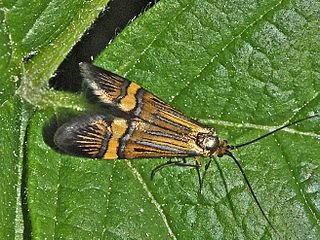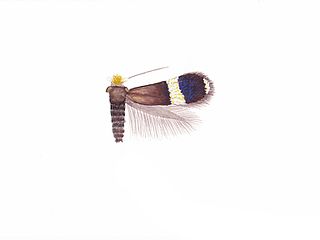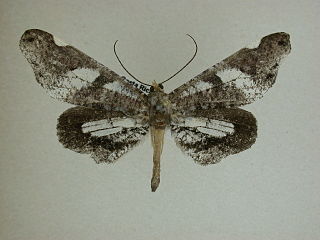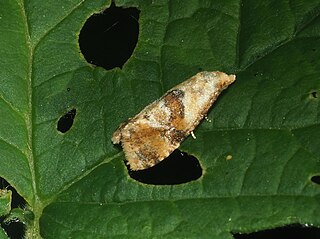
The ingrailed clay is a moth of the family Noctuidae. The species was first described by Johan Christian Fabricius in 1775. It is distributed through most of Europe and the Palearctic.

Micropterix is a genus of small primitive metallic moths, in the insect order lepidoptera within the family Micropterigidae. The name was raised by the German entomologist, Jacob Hübner in 1825 and comes from the Greek for mikros, little and pterux, a wing. The moths are distributed across Europe, south to North Africa and east as far as Japan.

Lethe europa, the bamboo treebrown, is a species of Satyrinae butterfly found in Asia.

Gangara lebadea, the banded redeye, is a species of hesperid butterfly found in Southeast Asia.

The longhorn moth or yellow-barred long-horn is a diurnal lepidopteran from the moths family Adelidae.
Bacotoma is a genus of moths in the subfamily Spilomelinae of the family Crambidae. It currently comprises 11 species, with an Oriental and Australasian distribution ranging from India and Sri Lanka over China and Southeast Asia to Australia.
Chrysophyllis is a genus of the grass moth family (Crambidae). It is monotypic, containing the single species Chrysophyllis lucivaga. This moth is very little known, having only been recorded once, before 1935. It belongs to the large grass moth subfamily Spilomelinae; at the time of its description, these were still included in subfamily Pyraustinae and the entire Crambidae was then merged with the snout moths. While its exact relationships are undetermined, it is believed to be a close relative of Talanga. Like these, the male genitalia of C. lucivaga feature a remarkably elongated aedeagus shaped like a bullwhip.
Tessema sensilis is a little-known moth species, the only member of genus Tessema. It belongs to the grass moth family (Crambidae), and therein to the large subfamily Spilomelinae; at the time of its description, these were still included in subfamily Pyraustinae and the entire Crambidae was then merged with the snout moths. While its detailed relationships are undetermined, it may be a close relative of Herpetogramma and/or Pilocrocis.

Micropterix mansuetella is a species of moth belonging to the family Micropterigidae and can be found in Europe, in very wet woodlands, fens and carrs. The moth was described by Philipp Christoph Zeller in 1844, but the larva and pupa are poorly described.

Stigmella auromarginella is a moth of the family Nepticulidae. It is found from Sweden to Portugal, Crete and Cyprus and from Ireland to Croatia. It is much more common in the southern part of the range.

Stigmella poterii is a moth of the family Nepticulidae. It is found from Fennoscandia to the Pyrenees and Italy, and from Ireland to Ukraine.

Schreckensteinia festaliella, the blackberry skeletonizer, is a moth of the family Schreckensteiniidae first described by Jacob Hübner in 1819. It is found in the Palearctic including Europe and has been introduced to North America
Tasmantrix thula is a moth of the family Micropterigidae. It is known from eastern Australia, where it is known from northern Queensland, from Devils Thumb and Mossman Gorge in the north to Mission Beach and from Herberton State Forest to Mission beach.

Nemophora congruella is a moth of the Adelidae family.

Macrosoma conifera is moth-like butterfly described by Warren in 1897. It belongs to the family Hedylidae. Originally it belonged to the genus Phellinodes. Malcolm J. Scoble combined it with Macrosoma in 1986.
Macrosoma hedylaria is moth-like butterfly described by William Warren in 1894. It belongs to the family Hedylidae. Originally it belonged to the genus Phellinodes. Malcolm J. Scoble combined it with Macrosoma in 1986.

Phalonidia aetheria is a species of moth of the family Tortricidae, the subfamily Tortricinae, and the tribe Cochylini. It is found in Brazil, in the states of São Paulo, Santa Catarina and Goias.

Macrosoma hyacinthina is moth-like butterfly described by William Warren in 1905. It belongs to the family Hedylidae. Originally it belonged to the genus Lasiopates. Malcolm J. Scoble combined it with Macrosoma in 1986.
Cheverella is a monotypic genus of snout moths in the subfamily Spilomelinae of the family Crambidae. It contains only one species, Cheverella galapagensis, which is endemic to the Galápagos Islands of Ecuador. Both the genus and the species were first described by Bernard Landry in 2011. The genus is placed in the tribe Udeini.

Phalonidia udana, or the loosestrife conch, is a European species of moth of the family Tortricidae, the subfamily Tortricinae, and the tribe Cochylini. It is widely distributed in the North Palaearctic but appears to be largely rare or missing in Central Europe. Previously, it was classified under the Phalonidia manniana taxon, but a recent effort to barcode all North European Lepidoptera revealed that P. udana and P. mannania are two distinct species.













